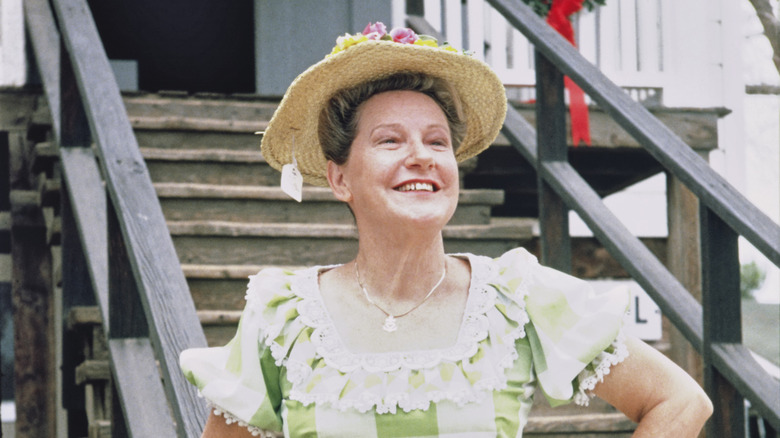The Retro KFC Rival That Was Named After A Female Performer From Nashville
Kentucky Fried Chicken inspired many imitators as it rose to fame, hoping to duplicate the success of the pioneering fried chicken chain that didn't actually begin in Kentucky. One short-lived rival that drew a flurry of headlines when it launched in the late 1960s tried to copy KFC's Colonel Sanders promotional tactic of having a well-known person as the face of the chain. It was named after popular Nashville performer and comedian Minnie Pearl, who appeared in the Minnie Pearl Fried Chicken logo holding a fried chicken leg in one hand and a basket of chicken in the other.
Sarah Colley created the down-home Minnie Pearl comic character, whose trademark was a straw hat with plastic flowers and a $1.98 price tag hanging down. She also had a "How-dee!" catchphrase that was adapted into the chicken chain's "How-dee-licious!" slogan. Pearl had been a Grand Ole Opry staple for decades when she lent her name to the franchise, and the future Country Music Hall of Fame member later became one of the stars of TV's "Hee Haw." (Another nostalgic chicken chain that deserves a comeback is named for another Country Music Hall of Famer — Kenny Rogers.)
Minnie Pearl Fried Chicken served fried chicken meals ranging from two pieces to a 21-piece party size, with sides including rolls, mashed potatoes, and coleslaw. "Grand Ole Extries" included chicken livers and gizzards (one of the worst kinds of food to order on a first date), Minnie's Taters, bar-b-q beans, potato salad, and Minnie's Fried Pie for dessert.
Minnie Pearl Fried Chicken's controversial fall
Minnie Pearl Fried Chicken lasted only five years, from 1968 to 1973, and its decline came amid a swirl of controversy. The original idea was the brainchild of Nashville attorney John Jay Hooker, who thought he could follow KFC's playbook. He got Pearl on board and launched the chain with his brother, and they got media attention that raised enthusiasm and helped sell franchises. Because of that, when the business went public in 1968, the stock shot up despite only five franchises actually being open at the time.
Hooker wanted people to believe the fried chicken recipe came from Pearl, but he actually had it created by a food lab. When customers sampled it, they weren't impressed. Some franchise cooks were also using their own recipes instead of the chain's, so the chicken wasn't the same everywhere. By 1969, franchises were going out of business, and the others were losing money.
The final nail in the coffin was a Securities and Exchange Commission investigation into how franchisee income was reported when the company went public. The brothers said they'd relied on what accountants told them, but had to reclassify some of that income as losses. Minnie Pearl Fried Chicken fell apart amid all these blows, and the last location closed in 1973. As for Pearl, she made a nice amount of money from cashing in her stock before it went south. But she was reportedly embarrassed that her name was associated with the disastrous business venture.


